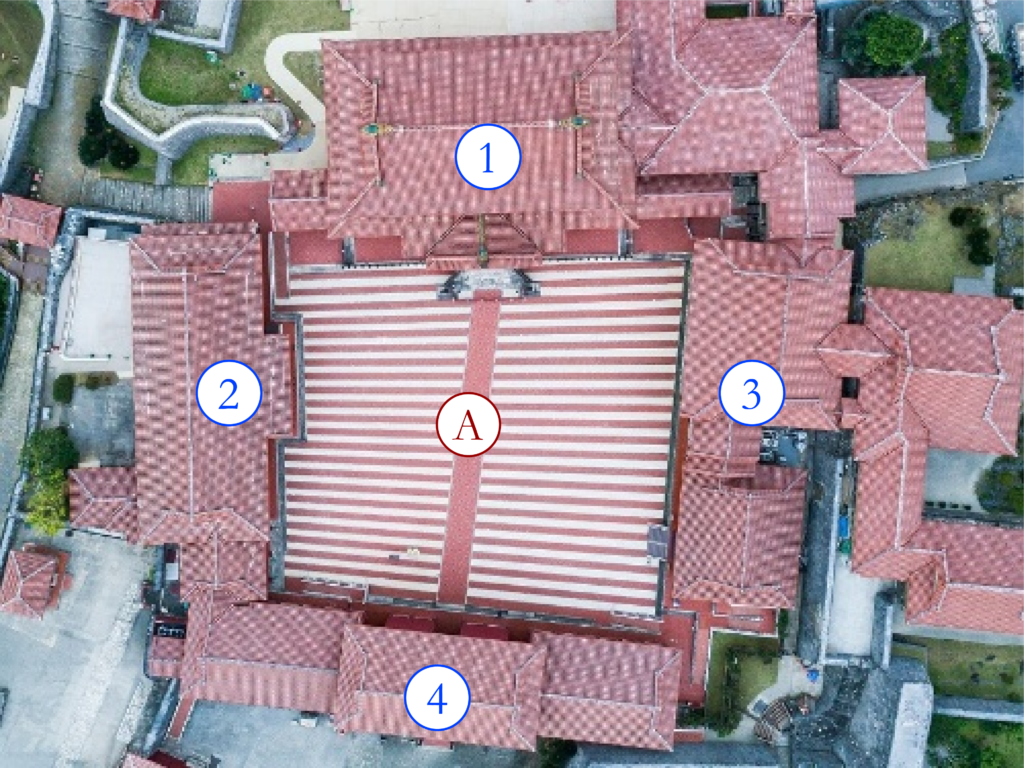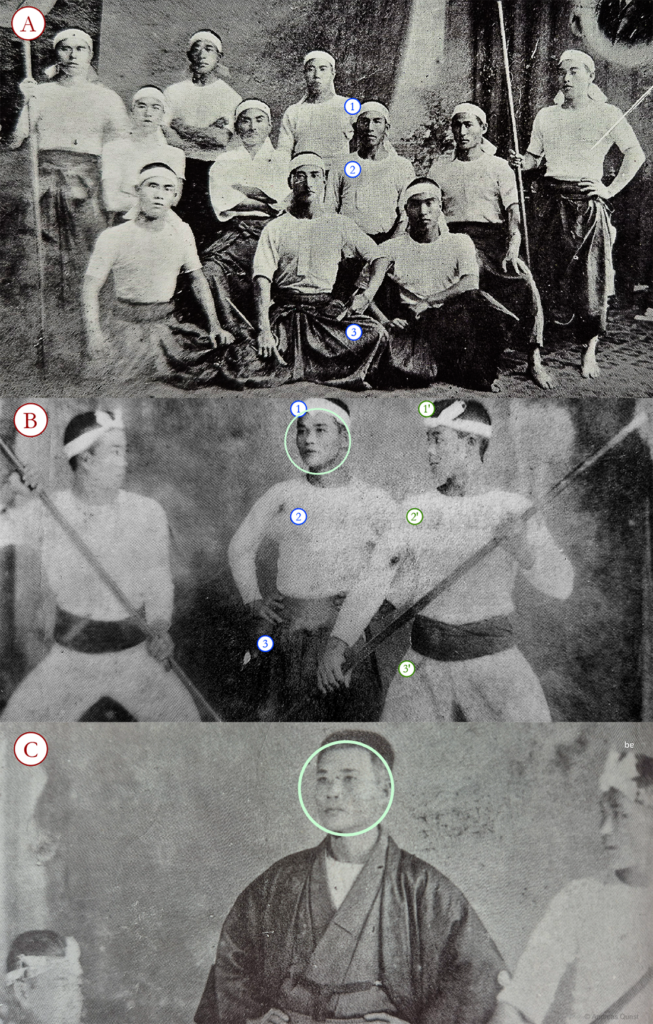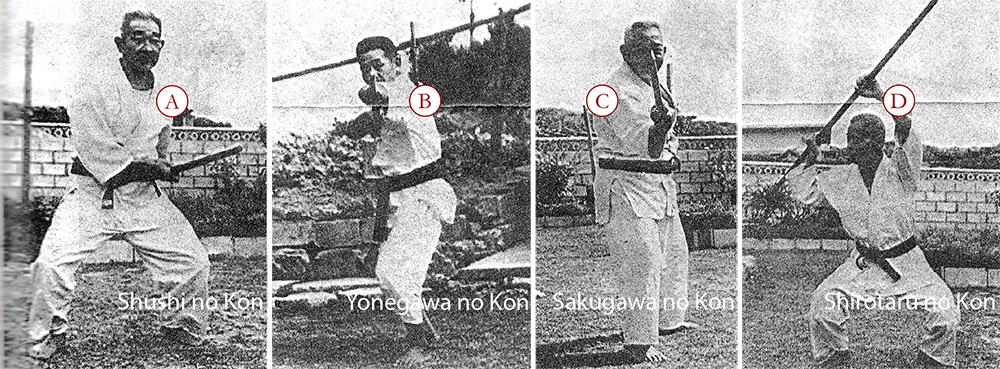On March 6, 1921, during Crown Prince Hirohito’s visit to Europe, the escort battleships Katori, captained by Okinawa-born Captain Kanna Kenwa, temporarily anchored in Nakagusuku Bay, and Crown Prince Hirohito took a light railway to Yonabaru. From there, he took a rickshaw to Naha Station, stopped at the prefectural office, and then traveled to Shuri. There are various reports of martial arts demonstrated for the crown prince during this occasion. The most famous is a karate demonstration led by Funakoshi Gichin, of which Funakoshi himself provided a commemorative photo in his earlier publications. Looking at Funakoshi’s photo, there are also bō and sai in the photo, so it is usually assumed that Funakoshi knew and taught bō and sai as a senior.
I would like to ask a few questions here. First of all, are the people in the photo Funakoshi’s students? Second, where there other martial arts performances?
Place of Performance
Often it is said that Funakoshi “led a karate performance” at the main palace (seiden) of Shuri Castle. It sometimes sounds as if it took place inside the main palace, but if you have ever been inside, this is doubtful from space limitations and also for reasons of the sacrosanct nature of this place. Instead, and as several sources indicate, martial art demonstrations took place on the courtyard (unā), which is the center of Shuri Castle. Standing on this courtyard, the main hall (seiden) is in front, the Northern Hall is to the left (north side), and the Southern Hall is on the right (southern side).
Various ceremonies were held on this courtyard throughout the year, and it is covered with rows of tiles of different colors that form a pattern for officials to line up according to rank during ceremonies. The central path was called the “Floating Road” because it was a path traversed only by a very limited number of people, such as the king or the Chinese investiture envoys, meaning they would float through yet above the other ranks.
From this reason, any martial art demonstration would probably have taken place on the left or the right side of the courtyard, but never in the center. There might have even been a temporary stage set up at any side, left or right, but details are unknown.
Students of Funakoshi?
As seen in Funakoshi’s photo, there was also bō and sai, but who were these people? Even though it is possible, I have never seen any source that was able to identify any of them as one of Funakoshi’s karate students.
Now, there were also other martial arts demonstrations on that day. For instance, in the stories of Kakazu village it is said that a welcome banquet was held for Imperial Crown Prince Hirohito on the courtyard (ūna) in front of Shuri Castle’s Main Hall, and that young men from Kakazu subvillage of Tomigusuku performed bōjutsu for his majesty.
Let’s compare the old photos to get more leads.
On top, photo A is Funakoshi’s photo. Funakoshi is seated in the center, with arms crossed. All wear the same clothes, namely a white headband tied in the rear (1), a white undershirt (2), and a black hakama (3). The only difference between Funakoshi and everybody else is that instead of a white undershirt, Funakoshi wears a white jacket with wider sleeves. This as well as his central position in the photo and posture with arms crossed most likely formally showed his seniority.
Photo B and C: Akamine Yōhei (left) and Higa Nisaburō (1900–81) from Kakazu, with unidentified leader in the center.
Below it, photo B shows the bōjutsu performers from Kakazu at the time. Just like everyone except Funakoshi in photo A, the central person in photo B wears a white headband (1), a white undershirt (2), and a black hakama (3). And this person was obviously the squad leader of the two young men and possibly more young men, who performed bōjutsu. These two young men also wear a white headband but tied in the front (1′) such as done in male dances of Okinawa, a white undershirt (2′), but instead of a black hakama they wear a dark sash and white trousers (3′).
From the comparison of above two photos A and B it seems that the persons in Funakoshi photos A were not necessarily his students who performed karate and kobudō led by Funakoshi, but possibly they were squad leaders of their own individual performing groups. They might have come from Shuri, or maybe even from various schools from Okinawa who led their own regional martial art team, just like the central person in photo B. The clothes they were wearing in these two photos most likely were the formal clothes standardized for this important event. If so, the performers’ clothes should have been such as those worn by the two young men left and right in photo B.
The two young men left and right in photo B are Akamine Yōhei (left, 1906–87) and Higa Nisaburō (right, 1900–81) from Kakazu. The squad leader in the center is unidentified, but it is the same person as in the center of photo C.
Who were the squad leaders?
The squad leader in the center of photo B and C allows for another option. Since the two young men left and right in photo B and C are identified as young men (seinen), it is possible and actually likely that among the martial arts performers were not only students of various schools, but also those from the socio-demographic group called “young men” (seinen), which refers to the group of young men after graduation from elementary school at around 13 or 14 until conscription into the military at age 20. Such young men were gathered in so-called young men corps (seinendan) in their subvillages, where they would take part in various activities under leaders, often local reservists, or soldiers, and would play sports and athletics, martial arts including bō and bayonet fencing, participate in each village’s events and so on. Like this, while the person in the center of photos A and B might have been a schoolteacher in Kakazu, he also might have been a leader of Kakazu’s local young men corps (seinendan). And this can also be said about the persons in Funakoshi’s photo.
What became of the bōjutsu of Kakazu?
The following is the inheritance as recorded in the Kakazu village tradition.
The origin of Kakazu Bō is Sakugawa Kanga (1762–1843), a samurē and native of Akata in Shuri, who was famously known as “Karate Sakugawa,” “Bō Sakugawa,” and Sakugawa Pēchin. Chinen Sanrā (1840–1922), commonly known as “Old commoner Yamannī,” inherited the bōjutsu from Sakugawa. Chinen Sanrā in turn began teaching bōjutsu to the young men (seinen) of Kakazu around 1922. Chinen’s students included Higa Sei’ichirō (1890–1991), Higa Raisuke (1904–89), Akamine Yōhei (1906–87), and Higa Nisaburō (1900–81), who studied Sakugawa no Kon, Shūshi no Kon, Yonegawa no Kon, and Shirotaru no Kon, respectively. Although Chinen Sanrā was already eighty-two years old at the time, he was very strong. The instruction was held in the yard in front of the village’s place of worship (uganju). All the disciples took off their tops, placed their hands together in prayer, and then began practice. It is said that the training sessions were so rigorous and earnest, like fighting with real swords, that fresh bruises never ceased to occur. It is also said that if Chinen Sanrā found it worthwhile, he would sometimes stay overnight to teach the young men.
After having received this instruction, the four men in turn continued to teach bōjutsu to the group of young men of Kakazu. The bōjutsu taught by the four was also practiced intensely, and in case of partner practice (kumite), the more inexperienced people were, the harder they hit each other with the bō, making loud noises and the bō would also often break, so much that even though two full-time carpenters were producing bō every day, they were unable to produce them in time.
It is said that Yamannī-ryū practice is so intense that if you miss by 15 mm, you will die, and before anyone knew it, it was feared by people in nearby villages as “Kakazu Bō.”
Inheritance of Kakazu Bō
The number of successors to Kakazu Bō, which demanded too strict discipline, gradually decreased, but Akamine Eisuke (1926–1999), the second president of the Ryukyu Kobudo Preservation and Promotion Association, mastered each of the four kata handed down by Old Commoner Chinen under the guidance of their respective masters.
Afterwards, his son Hiroshi (third generation chairman of the Ryukyu Kobudo Preservation and Promotion Association) took over this work, and while teaching at the Shinbukan dōjō in Nesabu, Tomigusuku City, he taught the four kata to his students as the “Yamanni-ryū no bō.” Today, “Yamanni-ryū no bō” has become Okinawa’s representative bōjutsu.
Note that the above is from a history book prepared by a subvillage community center, and is less reliable than a city history or even a prefectural or national history. The advantage however is that such histories of such small places include many personal stories of villagers, such as can be seen in this case of Kakazu Bō. To complement the given data, it should be noted here that Kuniyoshi Yukio, who took over as chairman of the Ryukyu Kobudo Preservation and Promotion Association in 2013, learned all of the four kata directly from Akamine Eisuke and also teaches them.
Btw, I also mention Kakazu Bō in my latest book, including a link to Sakugawa no Kon of Kakazu Bō (Yamanni no Bō).
© 2024, Andreas Quast. All rights reserved.



